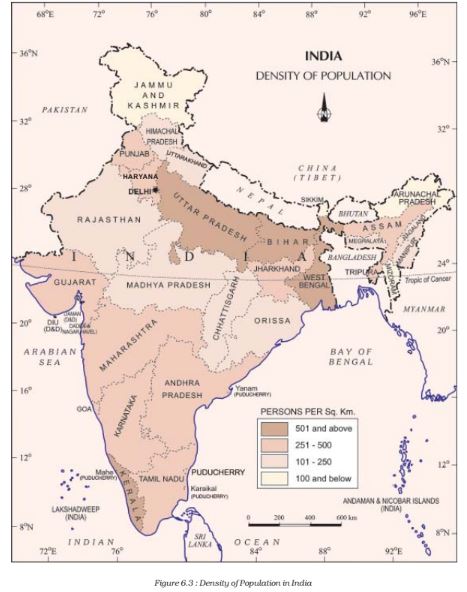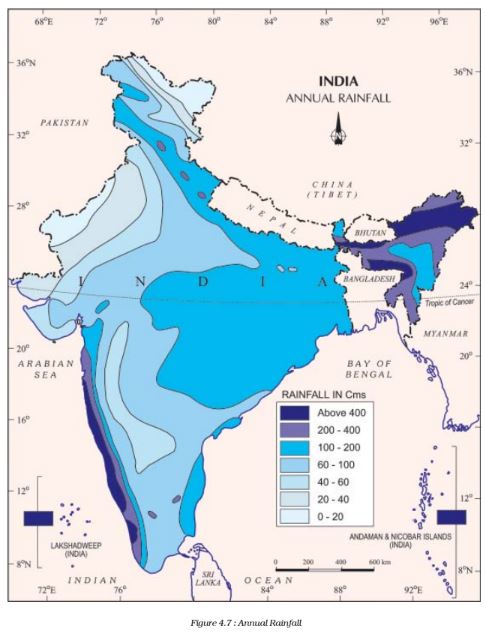NCERT Solutions for Geography, Chapter 6 – Population
Intext Questions
Page 54
Question 1. What could be the reason of uneven distribution of population in India?
Answer India has uneven distribution of population due to several factors like
(a) Low birth and high death rates areas.
(b) Topography Rugged terrain and unfavourable climatic conditions are primarily responsible for sparse population in states like Rajasthan and the hill states.
(c) Hilly, dissected and rocky nature of the terrain, moderate to low rainfall, shallow and less fertile soil are responsible for lesser population.
Question 2. Study the figure 6.3 and compare it with figure 2.4 and figure 4.7. Do you find any corelation between these maps?
Answer Yes, these maps show that the nature of relief and amount of rainfall act as determinants of the population density in an area. The areas with high density of population (501 and above persons per sq km) are those areas which are the plains and having high rainfall. Such areas are good for agriculture and so more people live in these areas. The areas with least population (100 and below persons per sq km) are hilly areas and so mostly unsuitable for habitation.
Page 56
Question 1 Table 6.1 reveals that despite the decline in growth rates, the number of people being added every decade is steadily increasing. Why?
Table 6.1
| Year | Total population | Absolute increase in the decade | Annual growth rate (%) |
| 1951 | 361 | 42.43 | 1.25 |
| 1961 | 439.2 | 78.15 | 1.96 |
| 1971 | 548.2 | 108.92 | 2.20 |
| 1981 | 683.3 | 135.17 | 2.22 |
| 1991 | 846.4 | 163.09 | 2.14 |
| 2001 | 1028.7 | 182.32 | 1.93 |
Answer The number of people increasing every decade population at beginning of the decade X Growth rate. Since the total population is growing every decade, even though the growth rate is reducing, it is not able to offset the increased total population, i.e., base population. So, the number of people being added every decade is steadily increasing.
Page 58
Question 2. Kerala has a sex ratio of 1058 females per 1000 males. Pondicherry has 1001 females 1000 males, while Delhi has 821 females per 1000 males and Haryana has just 861 females. What could be the reasons for such variation?
Answer Kerala and Pondicherry have a sex ratio of more than 1000 females per 1000 males while Delhi has 821 females per 1000 males and Haryana just 861 females because
(a) Kerala and Pondicherry have good health facilities, which reduces infant mortality.
(b) These states have higher literacy rates. Due to higher literacy of women, they are understanding the advantages of small families.
(c) In Delhi, there is a heavy migration of males who get jobs in the metropolis. Generally, their families stay back in their villages or home towns. This leads to a very high number of males in Delhi.
(d) In Haryana, female foeticide is rampant because of people’s desire to have a male heir, due to a patriarchal family system. This has led to the skewed sex ratio in Haryana.
Exercises
Page 60
Question 1. Choose the right answer from the four alternatives given below
(1) Migrations change the number, distribution and composition of the population in
(a) the area of departure
(b) the area of arrival
(c) Both the area of departure and arrival
(d) None of the above
Answer (c)
(ii) A large proportion of children in a population is a result of
(a) high birth rates
(b) high life expectancies
(c) high death rates
(d) more married couples
Answer (a)
(iii) The magnitude of population growth refers to
(a) the total population of an area
(b) the number of persons added each year
(c) the number of females per thousand males
(d) the rate at which the population increases
Answer (b)
(iv) According to the census 2001, a literate’ person is one who
(a) can read and write his/her name
(b) can read and write any language
(c) is 7 years old and can read and write any language with understanding
(d) knows the 3 ‘R’s (reading, writing, arithmetic)
Answer (c)
Question 2. Answer the following questions briefly.
(i) Why is the rate of population growth in India declining since 1981?
Answer Since 1981, the rate of growth started declining gradually because of popularised.
(a) Family planning measures were adopted, leading to decline in the birth rate.
(b) Awareness about advantages of small family came to be recognised.
(c) There was a growth of nuclear families occurred which adopted the small family norm.
(d) Promotion of family planning programme by the government.
(ii) Discuss the major components of population growth.
Answer The major components of population growth are birth rates, death rates and migration.
The natural increase of population is the difference between birth rates and death rates.
Birth Rate Birth rate is the number of live births per thousand person in a year. It is a major component of growth, because in India birth rates have always been higher than death rates.
Death Rate Death rate is the number of deaths per thousand persons in a year. The main cause of the rate of growth of the Indian population has been the rapid decline in death rates.
Migration Migration is the movement of people across regions and territories. Migration can be internal (within the country) or international (between the countries).
Internal migration does not change the size of the population, but influences the distribution of population within the nation.
(iii) Define age structure, death rate and birth rate.
Answer
Age Structure Age structure means the number of people in different age groups in a given population.
Death Rate Death rate is the number of deaths per thousand persons in a year.
Birth Rate Birth rate is the number of live births per thousand persons in a year.
(iv) How is migration a determinant factor of population change?
Answer Migration a Determinant Factor
(a) Migration is the movement of people across regions and territories.
(b) Migration can be internal (within the country) or international (between the countries).
(c) Migration is a determinant factor of population change, as it changes its size and composition.
(d) Internal migration does not change the size of the population but influences the distribution of population within the nation.
(e) In India, most migrations have been from rural to urban areas because of the ‘push’ factors in rural areas. These push factors are adverse conditions of poverty and unemployment in the rural areas. The ‘pull’ factors of the city are in terms of increased employment opportunities and better living conditions.
(f) These ‘push’ and ‘pull’ factors have led to increased migration from rural to urban areas and rapid rise in the urban population.
(g) There has been a significant increase in the number of ‘million plus cities’ from 25 to 35 in just one decade i.e., 1991-2001.
Question 3. Distinguish between population growth and population change.
Answer The differences between population growth and population change are given in the table below:
| Population Growth | Population Change |
| This refers to the increase in the number of inhabitants of a region during a specific period of time. | This refers to the change in the distribution composition of size of a population during a specific period of time. |
| Natural increase of population and immigration are the major components causing population growth. | Natural increase, immigration and emigration are the major components causing population change. |
Question 4. What is the relation between occupational structure and development?
Answer The distribution of the population according to the different types of occupations is referred to as the occupational structure.
(a) Occupations are generally classified as primary, secondary and tertiary.
(b) Primary activities include agriculture, animal husbandry, forestry, fishing, mining and quarrying, etc.
(c) Secondary activities include manufacturing industry, building and construction work, etc.
(d) Tertiary activities include transport, communications, etc.
(e) The proportion of people working in different activities varies in developed and developing countries.
(f) Developed nations have a high proportion of people in secondary and tertiary activities.
(g) In India about 64% of the population is engaged only in agriculture.The proportion of the population dependent on secondary and tertiary sectors is about 13 and 20% respectively.
(h) There has been an occupational shift in favour of secondary and tertiary sectors because of growing industrialisation and urbanisation in recent times.
Question 5. What are the advantages of having a healthy population?
Answer Health is an important component of population composition which affects the process of development. So we need a healthy population.
(a) The health of a person helps him/her to realise his/her potential and gives the ability to fight illness.
(b) A healthy person is an asset to the country, is more productive and helps in the progress of the country.
(c) A healthy person is able to earn more and improve his standard of living.
(d) A healthy population makes a healthy and strong nation economically and socially.
Question 6. What are the significant features of the National Population Policy 2000?
Answer Aims/Objectives of National Population Policy 2000
(a) Imparting free and compulsory school education upto 14 years of age.
(b) Reducing infant mortality rate to below 30 per 1000 live births.
(c) Achieving universal immunisation of children against all vaccine preventable diseases.
(d) Promoting delayed marriage for girls.
(e) Making family welfare a people centered programme.
(f) Protection of adolescent girls from unwanted pregnancies.
(g) Protection of adolescents from Sexually Transmitted Diseases (STD) and educating them about the risks of unprotected sex.
(h) Making contraceptive services accessible and affordable.
(i) Providing food supplement and nutritional services.
(j) Strengthening legal measures to prevent child marriage.



Leave a Reply